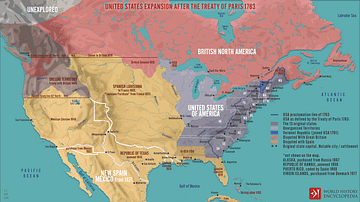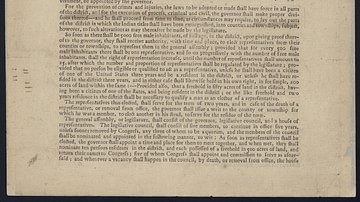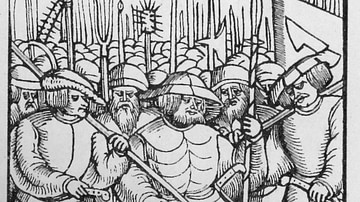
The Articles of Confederation and Perpetual Union was the first frame of government for the United States of America, establishing a weak federal government to protect the sovereignty of the states. Adopted by Congress in 1777, the Articles were effective from 1 March 1781 until 4 March 1789, when they were replaced by the current United States Constitution.
Under the Articles of Confederation, the central government (i.e. Congress) was a unicameral legislative assembly, comprised of delegates from the thirteen states. It was chaired by a President of Congress who, unlike the later office of the President of the United States lacked any executive power. Although Congress had the authority to declare war, make treaties with foreign powers, and resolve disputes between states, in most matters the central government was deliberately kept weak to protect the sovereignty of the states and could make no important decisions without the consent of at least nine states. This led to several problems, stemming from Congress' inability to levy its own taxes as well as its lack of a strong, standing army to provide for the nation's defense. Proponents of a stronger central government, known as Federalists, soon began to call for a revision to the Articles of Confederation. This ultimately led to the Constitutional Convention of 1787, in which the Articles were thrown out and replaced with the United States Constitution, which persists as the frame of the U.S. government to this day.
Drafting & Ratification
By June 1776, the American Revolutionary War had been ongoing for a little over a year. King George III of Great Britain (r. 1760-1820) had recently rejected the Olive Branch Petition, a last-ditch offer of peace sent by the Second Continental Congress, and had declared the Thirteen Colonies to be in a state of open rebellion. To use the words of Thomas Jefferson, the king's response left many Americans feeling as though the "last hope of reconciliation" between crown and colony had been severed, leaving the colonies with no recourse but independence; indeed, Thomas Paine's seminal pamphlet Common Sense warmed many colonists to the idea of independence, something that would have seemed unthinkable even a year before. Radical members of Congress had spent months garnering support for their cause and urging colonial legislatures to prepare for independence. Finally, on 7 June 1776, Richard Henry Lee of Virginia put a motion before Congress that "these United Colonies are, and of right to be, free and independent States…and that all political connection between them and the State of Great Britain is, and ought to be, totally dissolved" (Middlekauff, 331).
As the congressmen prepared to vote on Lee's motion, three committees were set up to begin laying the groundwork for a new nation. The first of these committees, the famous Committee of Five, was charged with the drafting of a Declaration of Independence, while the second committee was tasked with the creation of a 'model treaty' for establishing commercial relations with foreign powers. But it was the third committee that was given arguably the most important job of all: producing a frame of government for the 'perpetual union' that would bind the thirteen colonies together; in other words, they were drafting a constitution. This committee consisted of thirteen delegates, one selected from each colony, and was chaired by John Dickinson of Pennsylvania. It presented its initial draft of the Articles of Confederation to Congress on 12 July 1776, ten days after the vote for independence had passed.
The thirteen framers of the Articles had carefully considered the role that Congress would play in the new confederation. At a time when many Americans despised the British Parliament for its perceived corruption and tyranny, the framers wanted to avoid giving too much power to a central government that might one day become equally oppressive. Instead, they proposed a central government subservient to the individual states, arguing that this system was the best way to protect the liberties of American citizens. After much debate, Congress adopted the Articles of Confederation on 15 November 1777 before sending them off to the states for ratification. Virginia became the first state to ratify the Articles on 16 December 1777. 14 months later, the Articles had been ratified by every state except for Maryland, which was stubbornly holding out. Since the Articles needed the consent of all thirteen states before it could go into effect, the process of creating the confederation ground to a standstill.
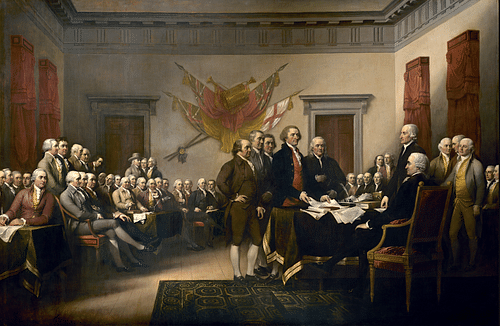
Maryland, a small state, was wary of the designs of its large and ambitious neighbor, Virginia. Maryland announced that it would not ratify the Articles unless Virginia gave up its claims on western territories, specifically the lands along the Ohio River. Many Virginians were initially indignant, and the stalemate continued for some time; all the while, Congress continued to operate as if the Articles were already in effect, adding to the legitimacy of the document. Finally, Virginia promised to renounce its claims to the Ohio territories. Satisfied with this outcome, Maryland ratified the Articles on 2 February 1781. On 1 March, the Articles formally went into effect, and the Second Continental Congress was rebranded as the Congress of the Confederation.
Articles
The version of the Articles of Confederation that went into effect on 1 March 1781 consisted of a preamble, 13 articles, a conclusion, and a section for the states' delegates to affix their signatures. Under the Articles, the states retained most legislative functions, except for a set of powers specifically designated to Congress, such as the ability to declare war and make treaties with foreign nations. Instead of being treated as provinces within a larger nation, each state was, essentially, its own mini republic, bound to the others through an alliance guaranteed by the weak central government. The provisions of all 13 articles are summarized below:
- Article I: The name of the confederation is officially recognized as 'the United States of America'.
- Article II: Each state shall retain 'its sovereignty, freedom, and independence' in every regard except for those powers specifically granted to Congress.
- Article III: By agreeing to the Articles, the states have entered a perpetual 'league of friendship', binding themselves to one another for the purposes of common defense, security of liberties, and 'mutual and general welfare'.
- Article IV: American citizens may travel freely between states and enjoy equal rights and privileges in each state they enter (i.e. Virginia must offer New Yorkers the same rights and privileges as native Virginians). Exceptions, however, are made for 'paupers, vagabonds, and fugitives from justice'. Any person who commits a crime in one state and flees to another must be extradited to the state in which the crime was committed to stand trial.
- Article V: Each state is allotted only one vote in Congress. States are allowed to have anywhere between two and seven congressional delegates. Delegates are to be chosen by state legislatures and may not serve in Congress more than three out of every six years.
- Article VI: Congress alone possesses the authority to declare war, conduct foreign policy, and make trade agreements. No state may wage war without Congress' permission or maintain a standing army in times of peace unless the state is attacked by pirates. Each state, however, must keep a ready and well-trained militia to be called out when necessary. Government officials cannot accept gifts from foreign dignitaries, and no American may accept a title of nobility.
- Article VII: Whenever an army is raised for the common defense, states are responsible for appointing all officers 'of or under the rank of colonel'.
- Article VIII: Congress cannot raise taxes on its own; instead, it must rely on a common treasury funded by the states. The amount of money states are expected to provide is decided by the property value of each state (notably, Congress cannot compel a state to donate money to the federal treasury).
- Article XI: The powers exclusive to the federal government include the right to levy war, to make treaties and alliances, to regulate the value of the coin, to establish post offices, and to issue letters of marque, among other things. Congress may not exercise these powers, however, without the consent of at least nine states.
- Article X: If Congress is in recess, its powers can be executed by a committee of any nine states, except for those powers that explicitly require Congress to be in session to be executed (i.e. declaration of war).
- Article XI: If Canada wants to be admitted into the confederation, it shall be. But no other colony is to be admitted without the assent of at least nine states.
- Article XII: All debts incurred by Congress or the states before the formation of the confederation will still be honored by the United States.
- Article XIII: The union between states is perpetual, and the Articles cannot be altered without the approval of Congress and the ratification of all state legislatures.
Governance Under the Articles
No sooner had the Articles of Confederation been ratified than cracks began to appear in the system of government it created. The most glaring issue was that, while Article VIII stipulated that each state had to provide funds for a national treasury, Congress had no power to compel them to do so. Congress was entirely at the mercy of the states for money and so, too, was the Continental Army, which relied on funds from Congress to sustain itself with equipment, clothing, and food. Consequently, the army was constantly undersupplied and undermanned; just as Congress could not compel the states to send money, neither could it compel them to send fresh recruits. Congress was also unable to fulfill promises it had made to Continental soldiers of bounties and military pensions, causing some soldiers to mutiny toward the end of the Revolutionary War. The most critical threat was the Newburgh Conspiracy of 1783, in which the outrage of mutinous Continental officers was deescalated only through the efforts of George Washington.
Before long, it became apparent that relying on the goodwill of the states was not going to be sufficient. Between 1781 and 1787, Congress only received $1.5 million of the $10 million that it had requested from the states during that period; if the new confederation was to survive, Congress would need to find a way to raise money independent of the states. A solution was offered in 1783 when a young congressman from Virginia, James Madison, proposed to amend the Articles to allow Congress to levy a five percent tariff on all imports. Madison's 'impost' tax received the support of Alexander Hamilton and even George Washington, and Congress approved the measure in April 1783. However, the Articles stipulated that no amendment could be made without the approval of all 13 states; by 1786, every state legislature had approved the amendment except for New York, which refused to approve it unless several alterations were made. The plan to give Congress even a small ability to tax, therefore, fell apart because of the whims of a single state.
Despite these substantial weaknesses, the Confederation Congress did have some legislative successes. Most significantly, it ratified the Treaty of Paris of 1783, which officially brought an end to the War of Independence and showcased the central government's ability to make treaties. Additionally, the Confederation Congress passed several major land policies. The Land Ordinance of 1785 established a system to allow settlers to purchase and develop untamed lands in the West; purchase of these lands also provided Congress with a much-needed source of income. This was followed by the Northwest Ordinance of 1787, which incorporated the so-called Northwest Territory into the United States and established procedures whereby new states could eventually join the union.

Replacement
By the mid-1780s, many Americans were concerned that the weakness of the central government would doom their new country to an early death. Foreign powers were not oblivious to the frailty of the United States and, like sharks drawn to blood in the water, were eager to exploit this vulnerability. Spain took advantage of the uncoordinated US foreign policy to negotiate the 1786 Jay-Gardoqui Treaty, in which the United States agreed to give up all access to the Mississippi River for 25 years; although Congress refused to ratify the treaty and it never went into effect, it showed the boldness of European diplomats when dealing with the Americans. Britain, too, taunted the United States' military weakness by refusing to withdraw its troops from the frontier fortresses on American soil, despite having pledged to do so in the Treaty of Paris. Instances like these made it quite clear that, if the Articles of Confederation were not revised, the United States would be ripped apart by its adversaries; as early as 1784, Washington wrote with apprehension that the Confederation Congress was "a half-starved, limping Government that appears to be always moving upon crutches, and tottering at every step" (mountvernon.org).
Another point of crisis came in late 1786 when farmers in western and central Massachusetts rose in revolt; burdened by high taxes and insurmountable debt, the farmers faced land foreclosures and debtor's prison, punishments they felt were contrary to the principles of the United States. The uprising, known as Shays' Rebellion, struck fear into the Massachusetts coastal elite, who asked Congress for help; Congress, however, lacked the funds necessary to raise an army and could do nothing. The Massachusetts elite ended up pooling their funds to raise a private army that succeeded in crushing the rebellion by February 1787. Although the rebellion was over, many Americans were left with a sense of dread, knowing that Congress was powerless to crush any future insurrections. Those who believed in a stronger central government, called Federalists, pointed to Shays' Rebellion as an example of why the Articles of Confederation were too weak to function.
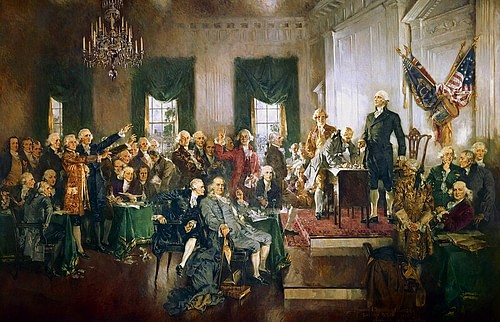
In May 1787, delegates from the states met in a convention in Philadelphia, Pennsylvania. Their initial task was to merely revise the Articles of Confederation; however, as the convention wore on, the delegates ended up drafting an entirely new framework of government that would become the United States Constitution. This new constitution would bestow more power onto the federal government, which would be divided into three distinct branches (executive, legislative, and judicial), each exerting checks and balances on the others. The Constitutional Convention adjourned in September 1787, and the Constitution was sent to the states for ratification. After months of fierce debate between Federalists and Anti-Federalists, the Constitution was finally ratified by the necessary nine states by 21 June 1788, with New Hampshire becoming the ninth state to ratify. The Constitution therefore went into effect on 4 March 1789, officially replacing the Articles of Confederation.


